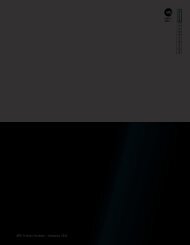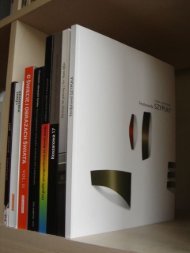akademia 2007+
o sztuce - ASP Katowice
o sztuce - ASP Katowice
- No tags were found...
You also want an ePaper? Increase the reach of your titles
YUMPU automatically turns print PDFs into web optimized ePapers that Google loves.
summary<br />
The Academy of Fine Arts in Katowice, since it became independent in<br />
2001, organises nationwide scientific conferences, habitually followed by<br />
conference publications consummating the event. The history of this volume<br />
is slightly more complex than usual. It includes a selection of texts<br />
resulting from three national conferences organised by the Academy at<br />
the initiative of the Department of Art History and Theory. The first conference,<br />
Graphic art – perspectives took place in the autumn of 2005, the<br />
second, Modern art contexts, in the autumn of 2006, and the third, Academy<br />
2007 +, in January 2008. Several texts (Adam Romaniuk, Adam Bartoszek)<br />
were especially commissioned to complete the emerging whole.<br />
Two of the essays printed here have been published before: the text by<br />
Grzegorz Dziamski and one of the two by Antoni Porczak. The idea behind<br />
publishing this book arose from some obvious substantial considerations:<br />
the current state of affairs in art in general and at the Academy<br />
in particular. The texts in this volume comment on that state at a particular<br />
point in time and in a more narrowly defined area: graphic art. There<br />
are no references to other artistic fields like painting on the one hand and<br />
design on the other, with the sole exception of the Ewa Stopa-Pielesz text.<br />
There is no reason for it other than that in the field of graphic art during<br />
the past few years there have been tendencies that changed its self-identification<br />
the most, and therefore have been widely discussed, namely the<br />
passage from traditional to digital media.<br />
The volume is composed of four parts: On art, On graphic art, On<br />
the Academy, On the problems of art. The first part comprises five texts, commenting<br />
on the current state of affairs in art in broader terms. The text by<br />
Andrzej Kisielewski Pastiche strategy, or the presence of avant-garde tradition<br />
today, presents how the universalistic demand of historical avant-garde is<br />
shown from the perspective of a researcher – art historian in a time when<br />
the commonly employed strategy is that of parody, euphemistically called<br />
pastiche. It uses the examples of the outstanding personalities of Polish art<br />
in the 1990s and the beginning of the 21 st century: Zbigniew Libera, Katarzyna<br />
Kozyra, Paweł Althamer, Elżbieta Jabłońska and Robert Maciejuk.<br />
The text by Bernadeta Stano, The atopic interiors of Christian Tomaszewski<br />
and Robert Kuśmirowski, points to a problem similar in its nature, but located<br />
within the matter of creation itself. By performing a critical decomposition<br />
of the two artists’ exhibitions, the author reveals their constitutive<br />
relations, which are the real and unreal, created readymade, copy-original,<br />
real illusion, the presence of a trespasser, and above all the artist’s mockery,<br />
this time directed against himself. An unusual conclusion to this issue<br />
is the subject of the artistic strategy of Wojciech Ćwiertniewicz, discussed<br />
by Janusz Antos. The text Practicing utopia. On the relation between<br />
modernist abstractions with circles and the Diaries of Wojciech Ćwiertniewcz<br />
shows the consistency of the artist’s reflections expressed in his diaries<br />
and the artistic practice of painting circles. It reveals itself as an unusual<br />
meditative pose and a way to penetrate abstraction, practicing a private<br />
utopia. Apparently from a completely different side, but in fact similar, the<br />
problem of teaching art history appears in a extensive presentation of the<br />
works of a Japanese artist in the text The art of Nobuyoshi Araki, or the dilemmas<br />
of an art history teacher. The artist, considered a source of controversy<br />
and confusion, as the ambivalence surrounding him seems to be<br />
very skilfully animated by a precise dosage of gestures ranging from pornographic<br />
(all possible variations of female nudes, including bondage) to<br />
verging on exhibitionism (showing his beloved wife suffering and dying<br />
of cancer). In the end, the resulting sadness and loneliness of man in the<br />
world is another universal story of humanity. The final text, Citations or<br />
translations? The reinterpretations of old art in contemporary Polish art by<br />
Violetta Sajkiewicz is devoted to the phenomenon of imitative techniques<br />
common in contemporary art. Referring herself to the analyses by Beata<br />
Frydryczak, Stanisław Czekalski, as well as Bryson and Mieke Bal the<br />
author analyses the art of Agata Bogacka, Paulina Ołowska, Zofia Kulik,<br />
Przemysław Kwiek, Anna Ostoya, Kamil Kuskowski, Grzegorz Sztabiński,<br />
and Marek Glinkowski.<br />
The second part is devoted to ongoing discussions within the<br />
field that return to confront the fundamental question: what is graphic<br />
art? Asking this has become relevant again due to turbulent changes<br />
caused by the widespread use of digital techniques in the creation, record-<br />
300 301






